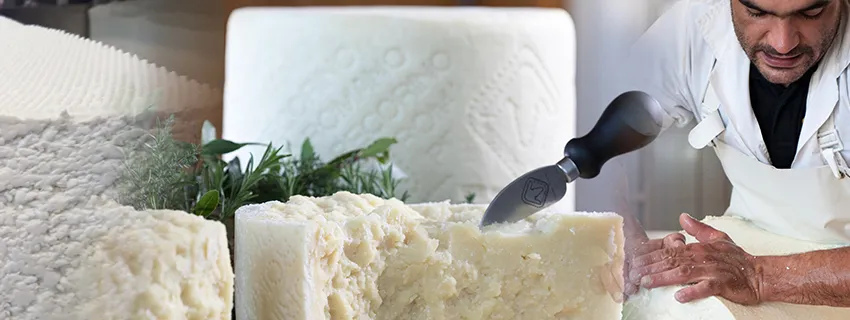Published:
Author: Antonio Maria Guerra
Pecorino Romano Cheese
HISTORY, INFO, PLACES, INTERESTING FACTS

Pecorino Romano cheese is one of the most famous Italian dairy specialties. Its origins, as it’s easy to understand from the name, are closely connected to the historic city of Rome and, more generally, to Lazio Region. Not surprisingly, it’s fundamental ingredient in many of the most typical dishes of this territory: delicacies such as ‘Spaghetti alla Carbonara’ and ‘Bucatini all’Amatriciana’.

What is Pecorino Romano cheese?
‘Pecorino’ is a type of Italian hard cheese made from sheep’s milk: an ingredient that makes it particularly tasty. The origins of this dairy specialty are very ancient and can be generally located in the Mediterranean area. There are many types of Pecorino: while sharing the same name, each of them stands out for its particular flavor.
In this article we’ll show you the production method currently used for Pecorino Romano PDO cheese. To read it, please click this LINK.


The history of Pecorino Romano cheese.
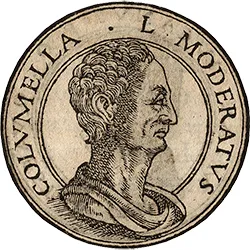 ‘Pecorino’ should be counted among the most ancient cheeses. According to many scholars, its birth could date back to a historical period prior to the Classical Age.
‘Pecorino’ should be counted among the most ancient cheeses. According to many scholars, its birth could date back to a historical period prior to the Classical Age.
We know for sure that it was much appreciated by the Romans: many are, in fact, the references to this specialty in the works of some of the most famous writers of the time, such as Columella (*1) who, in his ‘De Re Rustica’, accurately describes its preparation procedure. On a related note, it’s interesting to remember that the legions made extensive use of this dairy product, taking advantage of the features that made it particularly suitable for the needs of an army (*2), namely its nutritional value, portability and long conservation.
The passage of centuries has not affected the great value of Pecorino: this value has been recently recognized by the European Union with the assignment of the PDO mark (Protected Designation of Origin) to different types of this cheese.
Notes:
*1: Lucius Junius Moderatus Columella (4 – 70 AD).
*2: In one of his writings, the famous poet Virgil mentions the ration of Pecorino cheese assigned to each legionary.

Pecorino Romano Cheese
THE MOST TRADITIONAL PRODUCERS
This article is the result of the collaboration between WebFoodCulture and the Consorzio per la Tutela del Formaggio Pecorino Romano, organization gathering the most traditional producers of the famous dairy specialty.

Perocino Romano PDO in video.

Pecorino Romano PDO.
‘Pecorino Romano’ is not the only type of Pecorino on the market, but it’s probably the most known. Although it’s originally from the Italian Region of Lazio, it’s important to stress the fact that nowadays a great part of the production of this hard cheese (*1) takes place in another Region: Sardinia. Made with fresh sheep’s milk (*2), this dairy specialty stands out for its strong flavor, characterized by a delicious sapidity. It’s sold in wheels, whose edge (the ‘scalzo’) is branded with the symbol of the Consortium (*3), certifying its quality. Its rind is thin and ivory-colored, the inner part is of a tint blending white and straw yellow.
In 2002 the European Community awarded Pecorino Romano with the PDO (Protected Designation of Origin) mark.
Notes:
*1: Hard cheeses distinguish themselves for the low water content and the long aging.
*2: Whole milk: its places of origin are specified in the product specification document.
*3: The mark of the Consortium for the Protection of Pecorino Romano Cheese represents the stylized head of a sheep.

The seasoning of Pecorino Romano cheese.
The Specification document for Pecorino Romano DOP requires that this cheese can be marketed not before at least 5 months of seasoning for the fresh type, and at least 8 months for the aged type.


The places of Pecorino.
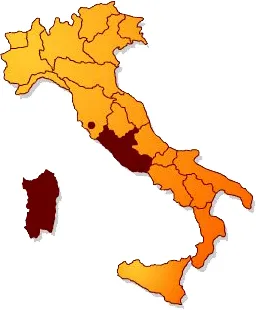 Many ‘taste lovers’ will probably be surprised discovering that, despite its name, a great part of the Pecorino Romano that ends up on our tables does not come from the Italian Region of Lazio, let alone from Rome (*1). Nowadays, more than 90% of this cheese is made in another Region, Sardinia. The specification document (*2) itself indicates this island, together with the Province of Grosseto and, of course, Lazio, as the only places where all the production phases of this dairy specialty must take place.
Many ‘taste lovers’ will probably be surprised discovering that, despite its name, a great part of the Pecorino Romano that ends up on our tables does not come from the Italian Region of Lazio, let alone from Rome (*1). Nowadays, more than 90% of this cheese is made in another Region, Sardinia. The specification document (*2) itself indicates this island, together with the Province of Grosseto and, of course, Lazio, as the only places where all the production phases of this dairy specialty must take place.
Why Pecorino Romano cheese is produced mainly in Sardinia?
Read more
To understand the reason of this (only apparent) oddity, it’s important to remember that, between the end of the 19th century and the beginning of the 20th, the export of Pecorino, especially towards North America, experienced a great increase (not surprisingly, this country was full of Italian emigrants). The production from Lazio was no longer able to meet the growing demand: this forced the dairy entrepreneurs (*1) to build factories in Sardinia, region which had always been famous for its sheep pastures.
Notes:
*2: The ‘disciplinare’.
*3: One of the many causes that led to the delocalization was probably the decree with which, in 1884, the Mayor of Rome Leopoldo Torlonia, established that the Roman grocers (the ‘pizzicaroli’), could no longer salt Pecorino inside the city walls, as they always used to do.
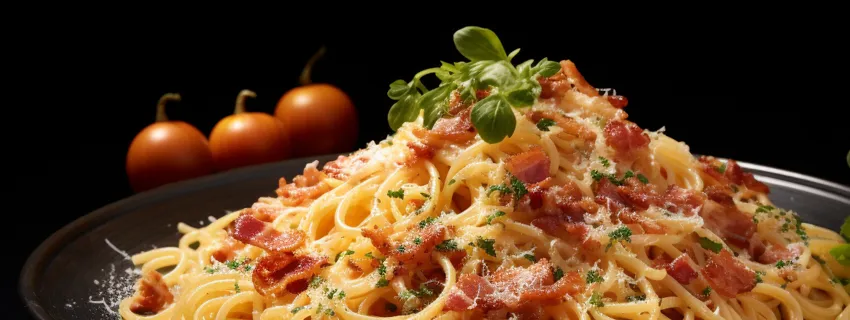
Specialties made with Pecorino.
Pecorino Romano is a fundamental ingredient in the preparation of many of the most important specialties belonging to the Roman and Latium culinaty traditions. Iconic dishes, incredibly rich in taste, such as:
Read more
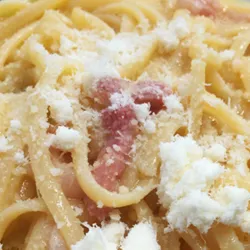
Spaghetti alla Carbonara.
Prepared with spaghetti, egg yolks, bacon, black pepper and Pecorino Romano PDO.
(Recipe)
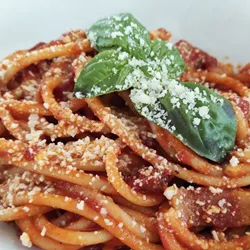
Bucatini all’Amatriciana.
Prepared with bucatini, bacon, peeled tomatoes, olive oil, white wine, chilli pepper and pecorino romano DOP. (Recipe)

Spaghetti Cacio e Pepe.
Prepared with spaghetti, black pepper and Pecorino Romano PDO. (Recipe)
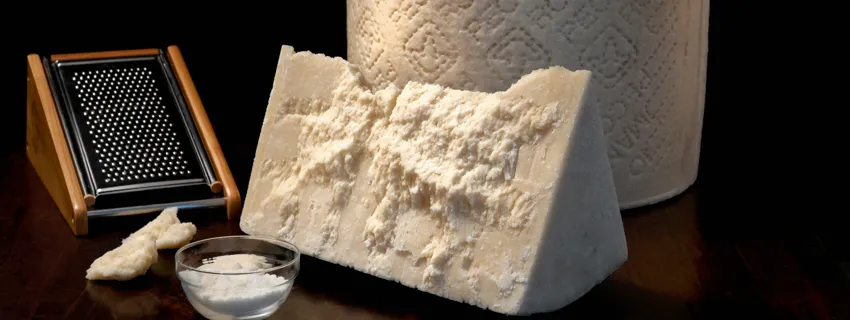
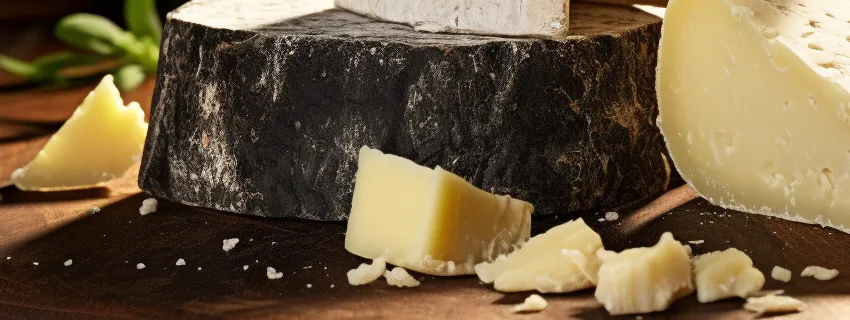
Other types of Pecorino cheese.
Pecorino Romano is not the only type of Pecorino cheese on the market. To give an idea of the great variety of Italian ‘Pecorini’ here follows the list of those awarded with the PDO Certification mark by the European Union.
Read more
- Pecorino Romano PDO;
- Pecorino Toscano PDO;
- Pecorino Sardo PDO;
- Pecorino di Filiano PDO;
- Pecorino Crotonese PDO;
- Pecorino di Picinisco PDO;
- Pecorino Siciliano PDO;
- Pecorino delle Balze Volterrane PDO;
Please keep in mind that many other types exist: each of them differs from the others for slightly different production techniques and organoleptic characteristics.
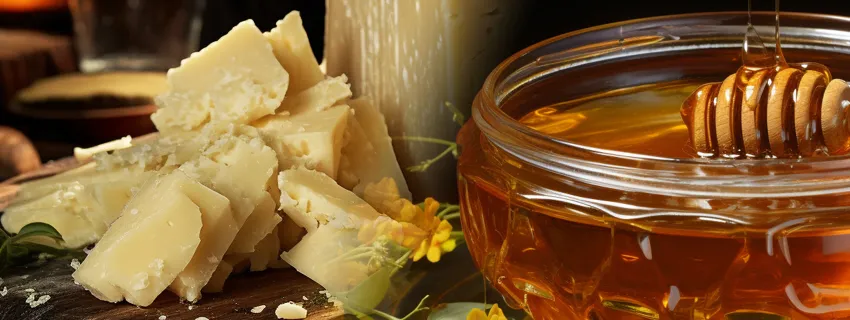
Pecorino Romano, pairings.
In addition to being an ingredient of fundamental importance for many of the most typical dishes of the Roman and Lazio gastronomic tradition, Pecorino Romano is perfect in many pairings further enhancing its taste. Among these pairings, the most famous are:
Read more
- Fresh Pecorino cheese and pears;
- Fresh Pecorino with and broad beans;
- Seasoned Pecorino and honey;
- Seasoned Pecorino and dried figs;
As it’s easy to understand reading this list, fresh pecorino is suitable to accompany delicate flavors, while the seasoned one balances perfectly much stronger tastes.
Seasoned Pecorino and onion compote.

Consorzio per la Tutela del Formaggio Pecorino Romano: contacts.
Address: Corso Umberto I, 226
08015 Macomer (Nuoro) – ITALY
Website: www.pecorinoromano.com
Mail: info@pecorinoromano.com
Tel.: +39 0785 70537
Copyright information.
The images displayed in this page belong to WebFoodCulture and to the Consorzio per la Tutela del Formaggio Pecorino Romano, with the exception of:
Public Domain images
- Portrait of Lucius Giunius Moderatus Columella (Wikipedia Link) {PD-Art} {PD-US}

